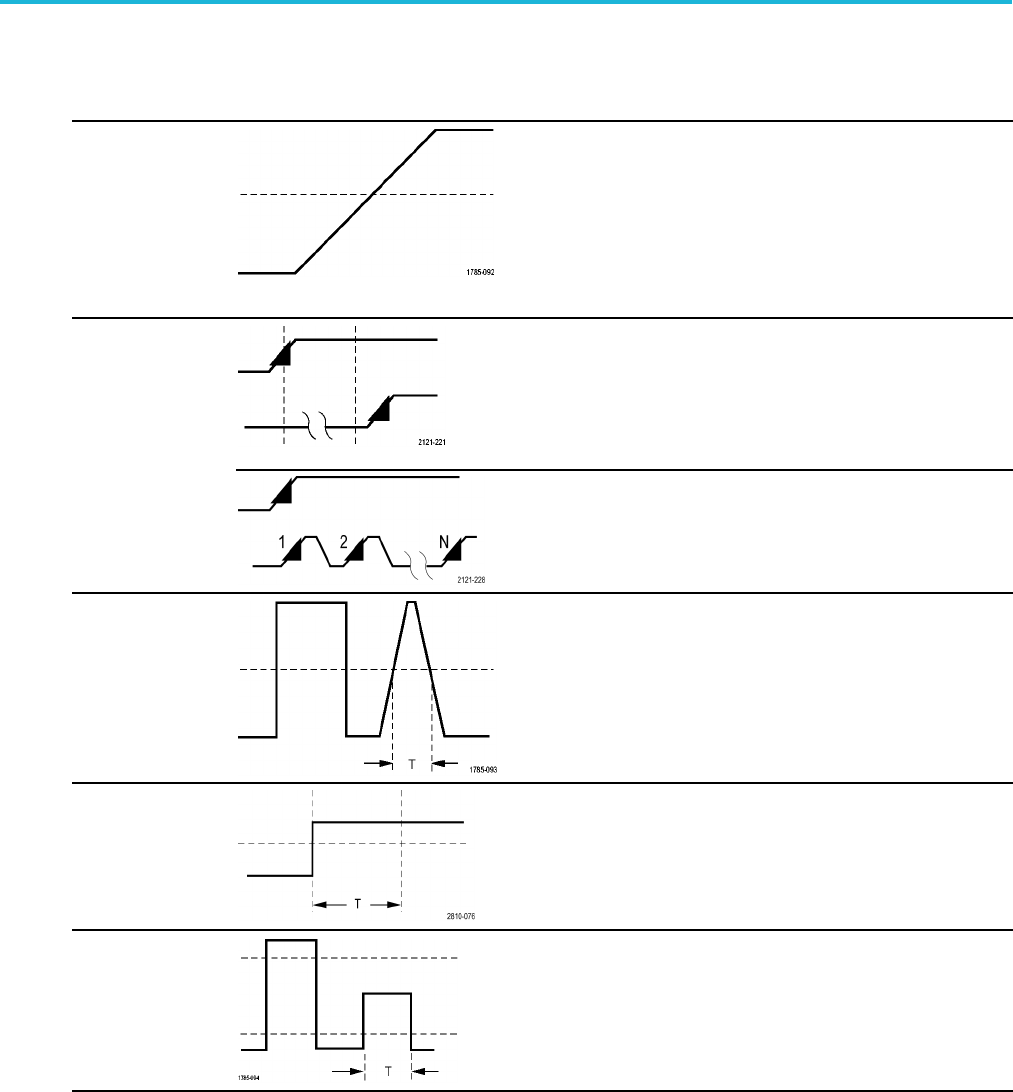User Manual
Table Of Contents
- toc
- Important safety information
- Compliance information
- Preface
- Installation
- Before Installation
- Operating Considerations
- Connecting Probes
- Securing the Oscilloscope
- Powering on the Oscilloscope
- Powering off the Oscilloscope
- Functional Check
- Compensating a TPP0250, TPP0500B or TPP1000 Passive Voltage Prob
- Compensating a non-TPP0250, non-TPP0500B or non-TPP1000 Passive
- Application Module Free Trial
- Installing an Application Module
- Upgrading Bandwidth
- Changing the Language of the User Interface or Keyboard
- Changing the Date and Time
- Signal Path Compensation
- Upgrading Firmware
- Connecting Your Oscilloscope to a Computer
- Connecting a USB Keyboard to Your Oscilloscope
- Get Acquainted with the Instrument
- Acquire the Signal
- Setting Up Analog Channels
- Using the Default Setup
- Using Autoset
- Acquisition Concepts
- Using FastAcq
- How the Analog Acquisition Modes Work
- Changing the Acquisition Mode, Record Length, and Delay Time
- Using Roll Mode
- Act on Event
- Setting Up a Serial or Parallel Bus
- Setting Up Digital Channels
- When and Why to Turn On MagniVu
- Using MagniVu
- Setting Up the RF Inputs
- Trigger Setup
- Display Waveform or Trace Data
- Adding and Removing a Waveform
- Setting the Display Style and Persistence
- Setting Waveform Intensity
- Scaling and Positioning a Waveform
- Setting Input Parameters
- Positioning and Labeling Bus Signals
- Positioning, Scaling, and Grouping Digital Channels
- Viewing Digital Channels
- Annotating the Screen
- Viewing the Trigger Frequency
- Displaying the Frequency Domain Menu
- Analyze Waveform or Trace Data
- Using Markers in the Frequency Domain
- Taking Automatic Measurements in the Time Domain
- Selecting Automatic Measurements in the Time Domain
- Customizing an Automatic Measurement in the Time Domain
- Taking Automatic Measurements in the Frequency Domain
- Taking Digital Voltmeter Measurements
- Taking Manual Measurements with Cursors
- Setting Up a Histogram
- Using Math Waveforms
- Using FFT
- Using Advanced Math
- Using Spectrum Math
- Using Reference Waveforms and Traces
- Using Wave Inspector to Manage Long Record Length Waveforms
- Auto-magnify
- Limit and Mask Testing
- Making Video Tests
- Making Automated Power Measurements
- Save and Recall Information
- Use the Arbitrary Function Generator
- Use the Application Modules
- Appendix A: Warranted Specifications
- Appendix B: TPP0250, TPP0500B and TPP1000: 250€MHz, 500€MHz and
- Appendix C: P6316 General-Purpose Logic Probe Information
- Appendix D: OpenSSL License

Trigger Setup
Selecting Triggers
Trigger Type Trigger Conditions
Edge
Trigger on a rising edge, a falling edge, or both edges,
as defined by t
he slope control. Coupling c hoices are
DC, LF Reject, HF Reject, and Noise R eject.
Edge triggers are the simplest and most commonly
used trigge
r type, with both analog and digital signals.
An edge trigger event occurs when the trigger source
passes through a specified voltage level in the specified
direction.
Sequence
(B Trigger) (not
available with an
edge slope
of
Both)
Combine an
edge A Event (Main) trigger with the B
Event (Delayed) trigger to capture more complex signals.
(See page 65, Act on Event.)
Time. Aft
er the A Event occurs, the trigger system waits
the specified amount of time, and then looks for the B
Event before triggering and displaying the waveform.
Events. After the A Event occurs, the trigger system
looks fo
r a specified number of B Events before
triggering and displaying the w aveform.
Pulse Width Trigger on pulses that are less than, greater than, equal
to, or no
t equal to a specified time. Additionally, you can
trigger when a pulse width is within or outside a range of
two different specified times. You can trigger on positive
or nega
tive pulses. Pulse width triggers a re primarily
used on digital signals.
Timeo
ut
Trigger when no pulse is detected within a specified
time. The signal stays above or below (or either above
or bel
ow) a set value for a set amount of time.
Runt Trigger on a pulse amplitude that crosses one threshold
but f
ails to cross a second threshold before recrossing
the first. You can detect positive or negative (or either)
runts, or only those wider than, less than, greater than,
equ
al to, or not equal to a specified width. Runt triggers
are primarily used on digital signals.
MDO3000 Series Oscilloscopes User Manual 93










